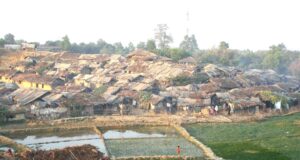Jamal smirked before quickly returning to the stony face of his.
“Quickly. In order not to penetrate our area.”
“Even if the soldier were alone and without a chance of escape?”
“Quickly. No torture.” Jamal knew what I was hinting at. The categorical rejection of torture, as an act of vengeance, was denied on the basis of their aim to simply keep the military away.
I was not convinced – I had a gut feeling that it was not so simple.
That vengeance is perceived by society as an act of violence that can never be condoned is clear enough. However can vengeance be condemned in light of the losses one has to endure? Were one to lose one’s dearest possessions and family members, wouldn’t it be justified to reciprocate the suffering onto the one who caused it? Admittedly, it can be considered base and even barbaric, and our moral principles tend to tell us that we should not go down that path. Yet we often also find ourselves entertaining the thought of exacting some form of punishment onto those we deem responsible for our losses – think of office politicking for one – even though that can never be compared to the horrors of conflict. How often are personal losses experienced by one party the cause of that party’s externalization of vengeance beyond the actual perpetrator of violence? And does vengeance actually lead to catharsis?
These were questions that raced through my mind as I listened to Jamal’s responses. I know that, were I to be caught in a similar situation, I cannot be sure that I will always be the “bigger person” that society calls for. We who have lived in the embrace of peace and stability expect others to rise above anger, hatred and vengeance. However, are we truly able to practise what we preach if we are ever to face the same events?
All of these therefore led to a bigger question. How was it that Jamal was seemingly above all this torture? Or perhaps more importantly, how was it that he was able to move from the role of both an actor of war and a victim to a peace builder?
Unsatisfied, I pushed for more answers.
Due to a lack of reporters on the ground then, alleged incidents of torture carried out by the Filipino military in Mindanao against the Bangsamoro people as well as MNLF fighters could not be confirmed. Nonetheless wouldn’t such information regardless of its authenticity create a desire to carry out similar actions against the military? To have one’s ethnic group tortured can be perceived as an action against a collective group.
“There was no torture until amnesty.” Apparently, the rumours were unfounded; at the very least in the areas that Jamal was active in.
In 1971, then President Ferdinand Marcos issued an amnesty to all Bangsamoro civilians and MNLF fighters. The official policy of the amnesty was to allow the people to return and resettle as civilians. Displaced people were brought back to their previous districts. It was perhaps an attempt at resolving the conflict.
“Torture even during evacuation of civilians. Therefore we went back to fight,” Jamal continued with a grin.
I knew what my next question was. I did not enjoy asking it, but I needed to know.
“The soldiers tortured the civilians during an amnesty.” Jamal leaned forward, listening intently. “Did you want to torture these soldiers?” I continued as his eyes blinked more frequently, “for what they had done to your community as a form of collective punishment?” He was clearly in deep thought and registering all that I had said.
Upon hearing the question, Matet decided to intervene and translate to ensure the intent of the question was conveyed.
As Matet translated, Jamal attempted to speak, but held himself back. Looking solemn, he shifted around in his chair, with one arm on the armrest. He looked into my eyes with deep intent. Before Matet was done, he responded affirmatively, “Yes, yes.” He clearly knew what I was getting at.
“Yes. We experienced it at Palembang. Soldiers closed the doors of the mosque and started shooting inside the mosque.” I could sense the rising rage within Jamal. It was something that I had not yet seen during the interview. Clutching his hand and forming it in the shape of a gun, he continued, “360 civilians killed in a mosque.”
Matet, Nicole and James were left shaking their heads after listening to Jamal. They were clearly horrified by the events that had just been described.
I wanted clarification. Did Jamal really want to torture these soldiers or had he been let on by my attempts to shape an outlook of him based upon my paradigm?
“What kind of anger did you feel? Did you really feel like torturing them?”
Jamal rubbed his nose, letting out a huge grin and chuckled. Before he could respond, Matet interjected, “I think he has already answered it.” Jamal did not respond to my question. He had left it to Matet. His grin perhaps said it all. One laughs in order to skid an uncomfortable subject and as an attempt at acknowledgement and also a signal to move on. He did have a desire to exact revenge through torture on the soldiers.
But if he had a desire to exact revenge and torture these soldiers, how did he then become a peace builder? If Jamal was not very much different from us, what enabled him to go beyond anger and hatred? While to feel such emotions that lead to revenge may be human, Jamal is perhaps an example that revenge and anger need not be the end point.
“When did you decide to lay down your arms? When did you decide to stop fighting as a soldier?”
“We never laid down our arms. But we stopped in 1973. We will never surrender our arms.”
I was left puzzled. Jamal is a peace builder who is still armed. The two ideas seemed to be in contradiction. “You do not surrender your firearms?” James, Nicole and Matet giggled as I scratched my head and attempted to reconcile the two differing ideas.
“We do not surrender our arms.”
Noticing that I was still at a loss, Matet turned around and tried to link the dots, stating that this was not an uncommon practice. “They fear that if they surrender their firearms, they will be hunted to the ground. So they hide their firearms just in case.”
Matet’s explanation clarified the paradox. But it is a reflection that much more still needs to be done to achieve real peace in Mindanao. This seemed to portray a peace that is ever so fragile and bitter; where opposing sides still do not fully trust each other and are prepared if things turn out for the worse. The government in Manila should do more to demonstrate that they are sincere parties to peace and reconciliation. A chance ought to be given so that a gun, which is three decades old, may finally be put to rest.
Jamal added onto Matet’s clarification, “Moros do not lay down their arms for fear of being hunted down by the military. We have a Koran and a gun in our homes.”
“Are you fearful that the military will hunt you down?”
Chuckling cheekily, Jamal replied, “no because there is an ongoing peace process. I am protected by the peace process.”
But surely the need to keep one’s arms suggests that one has not eliminated the possibility and fear of the worst to occur once more.
As the sun started to set, I had to leave my doubts aside to resolve another paradox.
Before Jamal decided to stop fighting in 1973, Marcos had declared a policy of “No Man’s Land”. This policy involved the burning and destruction of homes, livestock and the killing of civilians in the areas where Marcos was attempting to clear. In light of such a heavy-handed and brutal policy in Mindanao, how did Jamal undergo such a radical change of heart?
“The big question is Jamal, how did you then become a peace builder?” to the roaring laughter of all in the room. Nicole, James and Matet had been waiting for this.
“I do not want previous experiences to happen again. I do not want war.”
The answer was surprisingly simple.
“After the war, I was allowed to study. I was a Marcos scholar and was sent to study. After my studies, I became an official in Barangay.”
There was nothing big or spectacular. The answer to the biggest paradox lay in two short and succinct replies – a desire to not experience conflict again and a serious wish to reconcile and improve the lot of all in the conflict regardless of their status as victims or aggressors.
While the solutions may seem simple, that simplicity at the same time creates much hope and optimism. While we may not be able to rise above the anger, hatred and vengeance we feel, it is heartening to note that we are not consigned to unending conflict. It is a mere temporal phase that we may employ as a form of catharsis. What we seek, however, is a permanent escape from conflict and war; a very shared and human desire to not experience suffering once more.
Tangible, concrete and genuine attempts, regardless of history or status as combatants or victims, will build trust and change opinions of those who may have sought revenge due to rage and odium. Real solutions are not those that are grandiose, but those that move on from the cleavages that led to the conflicts in the first place.
As the sky darkened around Cotabato City, it was time to pack my items and head back to my residence.
Jamal did not choose be a child soldier; a continuum of events made a soldier in that child. And that same continuum finished with a peace builder.
[1] I was informed of this in a previous interview where he shared with me the experiences of his colleague in Cotabato City.
Please cite this article as:
Im, Z. (2013) ‘A Soldier in a Child’. Human Security Centre, Human Rights and Conflict Resolution, Issue 4, No. 3.
 Human Security Centre Human Rights and International Security Research
Human Security Centre Human Rights and International Security Research




